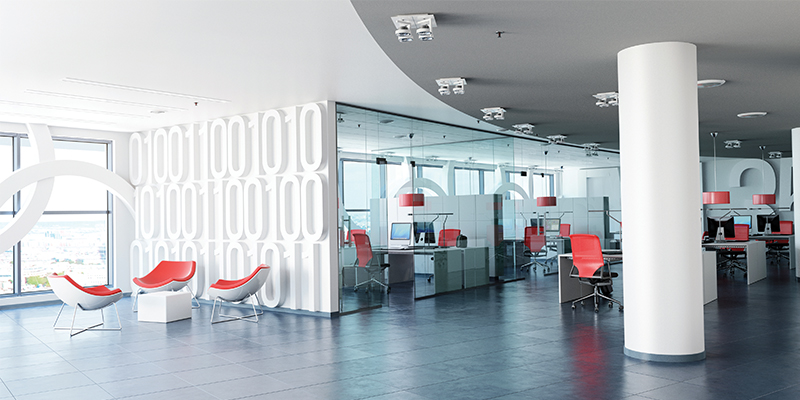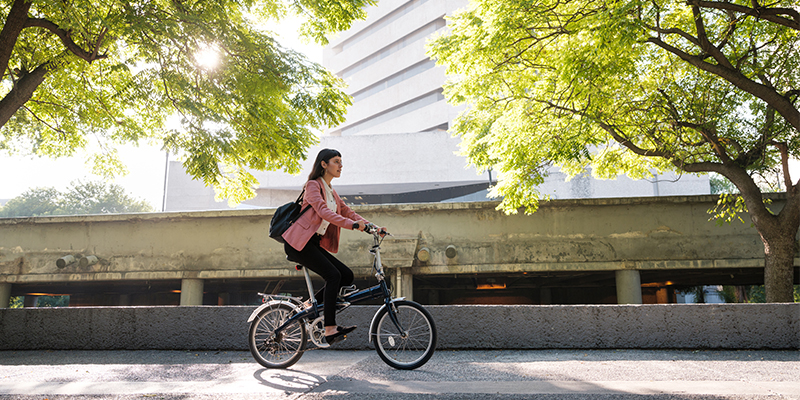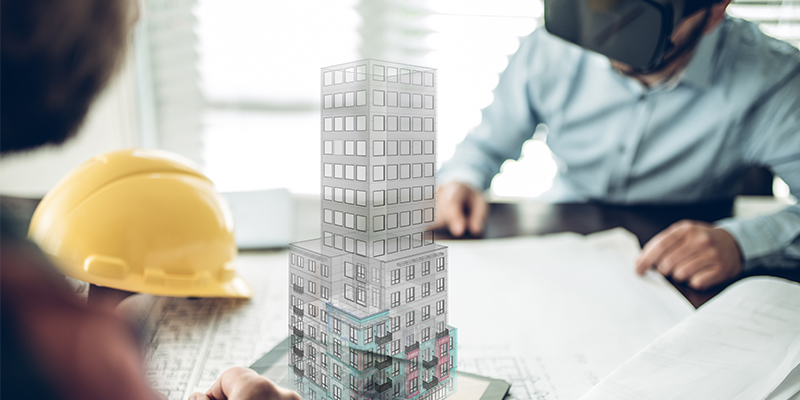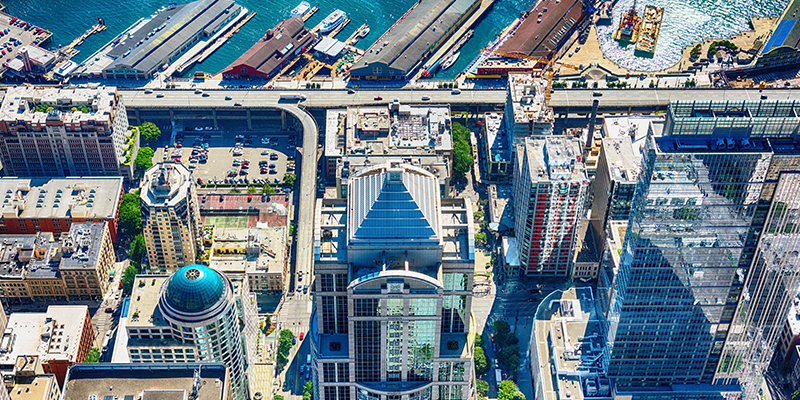The pandemic has forced us to rethink countless aspects of our lives, including the buildings we spend our days inhabiting. Social distancing requirements and efforts to reduce virus transmission in indoor environments demand that “healthy buildings” be a top priority for the real estate industry. But what constitutes a healthy building, and what are the differences between various building types? And what is the best way to quantify, track and compare the relative health of buildings? Offices spaces, hotels and even residential properties will want to find ways to differentiate themselves and quickly communicate their health and safety attributes to their respective occupants and consumers.
Healthy Buildings
According to Harvard researchers Joseph Allen and John Macomber, healthy buildings can help drive the performance and productivity of occupants while also supporting their health and well-being. Since indoor environmental quality can be tied to occupant productivity, the pandemic may produce a new quantifiable economic benefit to businesses inhabiting healthy buildings.
Healthy Building Certifications
Since the science and intricacies of how buildings relate to different aspects of our health is relatively new, communicating it as value-added cost may be tricky. However, the industry is not starting from ground zero. The U.S. Green Building Council’s Leadership in Energy and Environmental Design (LEED) is a third-party rating system developed to quantify and communicate information about building energy and environmental footprint and its impact on occupants and surrounding communities. Now, similar building “wellness” certifications have been created to focus on measuring and capturing information about the building system’s impact on human health.
For example, WELL is a performance-based system for measuring, certifying and monitoring features of the developed environment that impact human health and wellness. WELL is managed and administered by the International WELL Building Institute™ (IWBI™), a public benefit corporation whose mission is to help communities thrive through the built environment. WELL was founded on medical and scientific research and explores how to optimize design, operations and behaviors in the places we live and work. It measures how buildings connect to and can better serve their occupants using seven factors: air, water, nourishment, light, fitness, comfort and mind.
Fitwell, a competitor of WELL, addresses similar building health factors. It uses a point-based rating system of scorecards evaluating not only the individual site, but also the surrounding community. The scorecards include over 55 evidence-based design and operational strategies that enhance buildings by addressing a broad range of health factors and risks.
Such wellness certifications may better communicate long-term benefits and help instill confidence in returning occupants.
Office Space
The Centers for Disease Control and Prevention (CDC) released an updated COVID-19 Employer Information guide for office buildings on Sept. 11, 2020. Its message: “Check the building health to see if it’s ready for occupancy” by checking building operating systems. This, however, is only half the problem. What about how best to return the occupants to the building?
In response, many companies are upping their baseline square footage per employee to better ensure social distancing. This need for additional employee space will perhaps counterbalance the decreased demand for urban offices. While tech companies were at the forefront of allowing employees to work remotely, as the vice president of Amazon’s work force development articulated, they are betting “… talent attracts talent, and we believe that the creative energy of cities like New York will continue to attract diverse professionals from around the world.” Director of Development at TMG Partners David Cropper’s sentiments reflect a similar mindset. For TMG Partners, not much has changed as they keep their formula for success simple: ensure tenant occupants are ready to return and viable to meet rent, keep loans current, and be ready to pivot if the pandemic truly brings sustained long-term changes to urban office space demand.
Regardless of gross demand, going forward, tenants with the benefit of leverage will expect buildings to better address health impacts and seek evidence of better air quality and filtration, outside air circulation, touchless systems and other “smart features” as standard offerings. The pandemic has ensured that many “smart” building features that put health and safety concerns of indoor environments at the forefront will become the status quo.
But what happens when landlords do not take proactive steps to address minimizing health risks to occupants? Denise Kruger, senior vice president at Golden State Water Company, oversees over 30 offices in California, 12 of which are multitenant sites. In some instances, the burden fell on the company to implement change to promote safe re-occupancy by adopting internal policies. Examples of policies include promoting utilization of stairs (if possible), instituting one-way routes in certain office hallways to enable social distancing, ensuring single occupancy in elevators, separating open areas with partitions, installing HEPA filters and closing common areas.
Hotels and Safe Escapes
Travel restrictions associated with COVID-19 have caused people to cancel, adjust and reprioritize the ideal vacation. Many are selecting closer-to-home destinations to avoid air travel. This translated to a sales boom for RVs or recreational vehicle and camper van companies. Hotel and resorts that enable outdoor access have also been particularly sought after. Matt Walker, executive vice president of Lowe, notes the company’s long-held approach of acquiring and developing unique assets offering “authentic” lifestyle experiences aligns particularly well with the times. Lowe’s hotels, like other product types, of course have had to accommodate new health guidance and regulations including shifting away from daily maid service, and transferring to mobile phone “check-in,” to reduce nonessential face-to-face interaction between guests and staff. Not surprisingly, hotels with restaurants already offering outdoor terraces are retrofitting terraces to be even more expansive. Meeting areas are also moving outdoors.
Residential Properties
The pandemic is forcing developers to not only address health concerns, but rethink how they market their products and showcase a building’s health. The new health emphasis is seen in the results of a national home study that was conducted in late April of this year. Nancy Keenan, president of Dahlin Group, was one of the home development experts that co-sponsored the survey. The survey ranks design preferences in light of COVID-19. Top priorities include: germ-resistant countertops and flooring; greater technology and better energy efficiency; more storage for food and water; touch-free faucets, smart appliances and toilets; and better equipped kitchens and home offices.
The study also found a marked increase in people prioritizing home ownership, of which 72% would ideally purchase single-family homes. The messaging is clear: people in the fortunate position of choice would select larger living spaces and more access to outdoor living areas. The shift away from the rental market can be seen in the increases in rental vacancies. In New York, the vacancy rate is 5.1% in 2020, which is up 3% compared to 1.95% in 2019. In San Francisco, vacancies are 20% in 2020 (which is a 15% increase from 5% in 2019) and in Denver, it’s currently 6.42%.
According to Kati Blum, development director at East West Partners, their multifamily resort residences in less-dense suburban areas have also been doing well. Their product typically includes large porches and she foresees offering a variety of additional space options, such as home offices, extra dens, upgraded air systems and enhanced ease of stairway use.
Given the scale and toll of COVID-19, it is not unreasonable to anticipate many of these preferences and design elements will leave a lasting mark on our design aesthetic, architecture and built environment as a whole.














